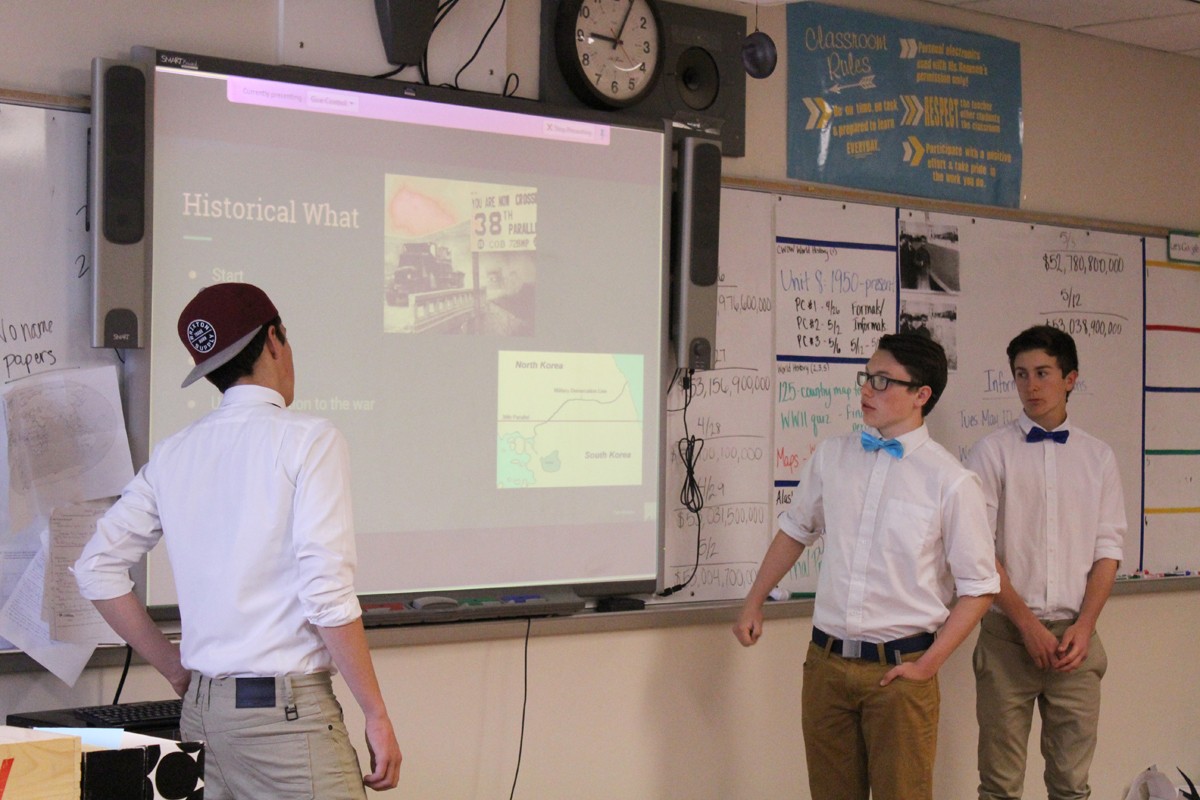Homer High School social studies teacher Kendra Nelson’s first period world history class includes students from Homer High School and Kenai Central High School, yet neither school has to make tricky travel arrangements.
Using video-conferencing technology, Nelson’s students connect with Greg Zorbas’ students in Kenai at the click of a button. Video conferencing allows Nelson and Zorbas to deliver lectures to both classes, as well as the students to connect with one another during class time.
Nelson’s class covers eight units over the course of the semester, going from pre-history through to the present. Instead of memorizing information from textbooks, the focus is on group projects that connect history with the present day. Students are asked to pick events from the period in history they are studying and work with others – usually a group comprised of half Homer students and half Kenai students – to relate it to a current event. At the end of the unit, the groups present to both classes, connected by video conferencing.
The model of simply learning facts and dates is becoming outdated in our current age of information, Nelson said.
“Now with technology we have all the answers at our fingertips that you would normally be asked in a history class,” Nelson said. “So Zorbas’ idea was to find a new idea to get students to still look at history, but in a way that’s still relevant to our lives.”
During a class session on Thursday, May 12, students brought to life the idea that learning history helps contemporaries avoid repeating humankind’s past mistakes. One group compared Republican presidential candidate’s idea to build a wall on the United States-Mexico border with the Berlin Wall, outlining the issues caused by the wall that split Europe in two for nearly three decades. The second group discussed the similarities between the Syrian Civil War and the Korean Civil War, outlining the factors that both caused and define both conflicts.
The students spend their class times talking with their group members via video chat, and using a shared document on Google Drive to create their project without ever being in the same room. Technology has made physical presence unnecessary for such teamwork.
This is Nelson’s first full school year of offering this new type of social studies class, which essentially functions without walls. Nelson was Zorbas’ student when she attended school in Kenai, before he began teaching courses using videoconferencing. When he learned his former student was a teacher at Homer High, he contacted her about starting a videoconferencing course of her own.
“It’s been a breath of fresh air having Kendra get involved in the program and being willing to change things from the way she teaches her other world history classes, and I commend her for taking another look at it and I’m really glad she’s part of the whole situation,” Zorbas said.
Zorbas has been working on this model for the last 12 years with Rob Sparks of Soldotna Prep. In recognition of their efforts in creating curriculum that connects students from schools around the Peninsula and around the world, the United States Distance Learning Association awarded Sparks and Zorbas the Best Practices Gold Level award for excellence in distance learning teaching. Zorbas and Sparks attended the USDLA conference in St. Louis, Missouri, where they presented to educators from all over the United States as well as in other countries.
“It’s validation for me. It’s another way that all the hard work and all the effort that we’ve put into changing the way we teach. We’re getting close to being able to retire and we’re not sitting here and passing out word sheets. We’re continually changing,” Zorbas said. “We’re continually hearing from professionals in not just education and not just (video communication technology), but multiple industry experts are telling us we’re preparing these kids to work in multiple work environments because that is what the world is changing to.”
In addition to world history, Zorbas also teaches three other elective courses using videoconferencing that connects his students to classrooms in Ghana, Malaysia and Palestine, through which they learn about world relations and eventually get to create their own curriculum revolving around video technology.
Currently, Nelson’s first period world history course is the only class she teaches using videoconferencing due to scheduling conflicts between the two schools’ different schedules. Through the course, they have used video to bring experts from all over the country into their classroom. A recent lesson on the protest music of the Vietnam War era featured a guest speaker from the Manhattan School of Music.
However, Nelson is working towards implementing the world relations electives that Zorbas teaches, which would allow Homer’s students to be a part of an international conversation.
“It didn’t work with this year’s schedule, but I think by the following year (the 2017-2018 school year), we’ll be able to integrate that here,” Nelson said.
Anna Frost can be reached at anna.frost@homernews.com.


